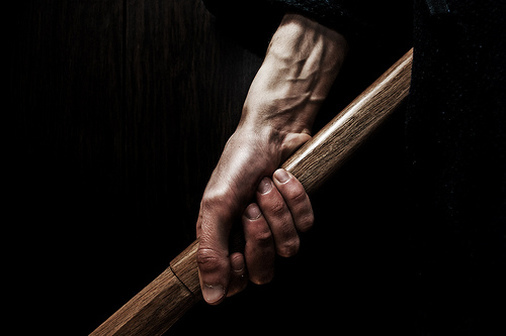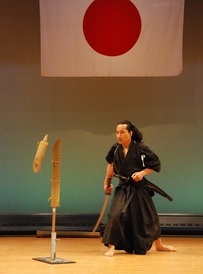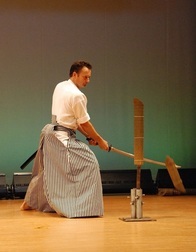Notes from Himeji, Japan: Moving Zen Part II
 “Think lightly of yourself and deeply of the world” ― Miyamoto Musashi
“Think lightly of yourself and deeply of the world” ― Miyamoto Musashi
 Tameshigiri - live target cutting Souke, my sword teacher, gave a speech at our annual gala performance last weekend. She reiterated what all teachers have said at least once in their lives: that making mistakes is vital to the learning process and that fear of failure can lead to unnecessary anguish.
Tameshigiri - live target cutting Souke, my sword teacher, gave a speech at our annual gala performance last weekend. She reiterated what all teachers have said at least once in their lives: that making mistakes is vital to the learning process and that fear of failure can lead to unnecessary anguish. To press her point she told of how, as an elementary student over a half-century ago, she performed an entire dance routine with a tack in her foot because she couldn’t remove it by herself and didn’t want to bother her teammates with the trouble.
Ouch.
Now in her 60s, she is worldlier, wiser, has sold her Hummer II and given up Camel Lights for low-tar alternatives. She is as nimble, quick-witted and supple-limbed as a teenager, presiding over the nightly sessions of iaido (the art of sword drawing), senbu (fan dance), kenbu (sword dance) and shigin (詩吟, poetic song) at her dojo of Kanshō-ryu (the Flying Crown sword style) in Himeji city, western Japan.
I remember how, only six months after walking through her door, she placed a shinken (‘live’ sword) in my hands; a blade that could have spliced the nose hairs on a fruit fly. It felt like an electric eel between my sweating palms—light, hot and flighty—and I handled it nervously, worrying that each time the blade departed the sheath, I was putting myself and the whole world in peril. I didn’t show my fear during practice, but the day I walked onto the stage at the City Culture Centre, three weeks later, I could hardly contain it.
 The Flying Crown sword style in action The Dai Hall was packed. There was standing room only for the big name kabuki star who was to appear later (our dojo providing the supporting act). While Mister Kabuki was calmly powdering his face out back, our dojo members sat in nervous ranks along the stage, concealed behind a long, heavy curtain. From the other side of this came the hum and murmur of 1,600 people—a cough here, a whisper there—belying the ocean of expectation which lapped at the stage. The older, experienced dojo members around me focused themselves, breathing deeply. The newer members fought to keep their Adam’s apples from defying gravity. “Standby!” came the stage hand's call from the wings. The curtain rose, and our dopamine levels with it.
The Flying Crown sword style in action The Dai Hall was packed. There was standing room only for the big name kabuki star who was to appear later (our dojo providing the supporting act). While Mister Kabuki was calmly powdering his face out back, our dojo members sat in nervous ranks along the stage, concealed behind a long, heavy curtain. From the other side of this came the hum and murmur of 1,600 people—a cough here, a whisper there—belying the ocean of expectation which lapped at the stage. The older, experienced dojo members around me focused themselves, breathing deeply. The newer members fought to keep their Adam’s apples from defying gravity. “Standby!” came the stage hand's call from the wings. The curtain rose, and our dopamine levels with it. The stage filled with whirling black hakama and the flashing sword blades of iaidoka performing kata to the best of their ability: hangetsu (the half-moon cut), fūjin (the wind god cut), fubuki (the blizzard cut) and on they went until it came time for the tameshigiri, the stylised cutting of rolled tatami mat poles. One by one, the targets fell in clean sweeps. In the Japan's Edo period (1600-1868), tameshigiri was performed on dead (and sometimes live) criminals to test sword blade-strength.
Then it was my turn to perform michizure (みちづれ). Roughly translated it means “the highway companion.” It's a technique which I feel embodies the philosophy of iaido and its so-called “moving Zen" form, in which the swordsman, perceiving the threat, acts on it clearly and cleanly. In the case of michizure, the 'threat' is an assassin tailing you. Thrust. Pivot. Strike. I remember the blade easing through the tatami fibres, the foul-smelling and water-logged roll drop with a thud to the stage floor.
As I returned the blade to its sheath, something bit my hand. A wet warmth glided down my fingers. I glimpsed blood on my toes but resumed my seiza position, pressed my hand into my hakama to stem the flow, and bowed. The audience applauded, none the wiser.
 Slice and dice... The most shameful mistake a samurai could make was to cut himself. Relieved, but despondent, I shuffled offstage. A veteran swordsman caught me by the sleeve and pulled me aside. “Nerves only get in the way," he gravelled. “Empty your mind and get on with it.”
Slice and dice... The most shameful mistake a samurai could make was to cut himself. Relieved, but despondent, I shuffled offstage. A veteran swordsman caught me by the sleeve and pulled me aside. “Nerves only get in the way," he gravelled. “Empty your mind and get on with it.” Seven years on, and countless performances since, those words still resonate. Failure never enters my mind when the sword closes on its target now. The blade does the hard work. The handler only sets it in motion, giving speed, angle and timing.
I still attend our dojo’s twice weekly training sessions, marking my progress by scarring, gashing, pock-marking and carving the floorboards and ceiling beams. I even managed to tear my hakama with my sword tip recently. But I see veterans do the same; they drop their fans, stumble and snag their spear tips on floorboards, forget their moves and stand dumbly as the music continues without them.
While she might bark and growl at these faux pas, Souke forgives. She still makes them herself. As the saying goes, 猿も木から落ちる. “Even monkeys fall from trees.”
 ...and finish nice. *Moving Zen Part I appears in the May 2014 archives.
...and finish nice. *Moving Zen Part I appears in the May 2014 archives.
Published on June 11, 2015 20:31
No comments have been added yet.



